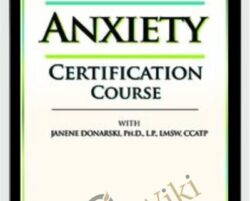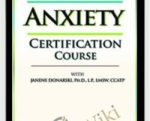Advances in neuroscience have provided a roadmap for the brain that shows us the key to working with anxious minds. But knowing how to interpret the complex map neuroscience provides has left many clinicians wondering … How do I unlock the complicated inner works of the brain to guide my client sessions?In this new, comprehensive certification training program recording, you’ll see how neuroscience can inform why, how and what techniques can help your clients stop the symptoms of anxiety – even tough to treat panic attacks, worry, rumination, nausea, and pounding hearts.Now you can watch Janene Donarski, Ph.D., LP, LMSW, CCATP, for a comprehensive step-by-step clinical training on how you can revolutionize your anxiety treatment approach with the power of neuroplasticity.More than just the neurobiological “whats and whys”, you’ll also learn the “hows” of actual treatment – so you’ll know exactly how to empower your clients with strategies to resist anxiety-igniting cognitions.You’ll leave this program recording confident in your ability and be fully prepared to integrate brain-based strategies that motivate lasting change for calming the mind – even in your most anxious, worried, or obsessive clients.Analyze the underlying neurological processes that impact anxious symptoms for clients.Evaluate the neurological processes underlying anxiety in a clearly understandable manner that enhances client motivation.Develop client engagement in treatment using personalized goals and attending to the therapeutic relationship.Prepare personalized goals to increase client engagement and focus client efforts on making lasting changes in the brain.Evaluate the differences between amygdala-based and cortex-based anxiety symptoms and identify how these symptoms inform treatment interventions.Apply strategies for calming and training the amygdala to alleviate symptoms of anxiety.Develop methods for teaching clients to retrain the cortex so that anxiety is resisted rather than exacerbated.Assess appropriate treatment interventions by determining whether the client is experiencing rebound anxiety or relapse symptoms.Analyze how psychotropic medication impacts neuroplasticity in the brain; identify related treatment implications.Use reframing exposure as an opportunity to teach the amygdala new responses to improve client engagement and treatment compliance.Execute client education exercises that can be utilized in session to train clients in the use of mindfulness techniques.Employ clinical strategies for managing comorbid depression that reduce worry, rumination, and common cognitive errors while promoting positive thinking and social interaction.Get 2-Day: Anxiety Certification Course – Janene M. Donarski, Only Price $175Using Neuroscience in the Treatment of AnxietyPositives:Causes and treatments knownCan explain the neurological symptomsScience provides evidence, authorityDe-stigmatizes disordersClinician concerns:You don’t have to be a neuroscientistOversimplification is inevitableFinding the right level of explanation is essentialEnhancing Engagement in TreatmentDon’t neglect the therapeutic relationshipFocus on personalized goalsAddress the challenges of anxious clientsRemember that strategies are effortfulGuide the process using client’s goalsMaintain motivationNeuroplasticityDefined in everyday languageNeurologically informed therapy goal”Change the brain” in desired waysMake the brain more resistant to anxietyCreate a new selfRe-consolidation: The modification of emotional memoriesNeuropsychologically Informed CBTStrategies can be used to effectively “rewire” the brainLong history of evidence supporting efficacySkills-based approachStrong focus on the presentPsychoeducation is essentialIdentify the Two Neural Pathways to AnxietyAmygdala – bottom-up triggering of emotion, physicality of anxietyCortex – top-down emotion generation based in cognitionHow to explain the pathways to clientsHow anxiety is initiated in each pathwayThe pathways influence each otherClient Friendly ExplanationsUse illustrations to create concrete understandingFight/flight/freeze responsesThe “language of the amygdala”Anxiety and the cortexHelp clients recognize the two pathwaysNeuroplasticity in the Amygdala Essential for all Anxiety Disorders, PTSD, OCD, DepressionSleep and the amygdalaThe influence of exerciseBreathing techniques to reduce activationRelaxation, meditation, and yoga to modify responsesExposure as opportunities for the amygdala to learnCombating avoidanceIndications that the amygdala can learn new responsesPush through anxiety to change the amygdalaNeuroplasticity in the Cortex Essential for GAD, SAD, OCD, PTSD, Depression”Survival of the busiest” principleStrengthen or weaken specific circuitryThe healthy (adaptive) use of worry in the cortex”You can’t erase: You must replace”Recognize and modify the impact of uncertaintyTraining correct uses of distractionLeft hemisphere techniquesCognitive defusionCoping thoughtsFighting anticipationRight hemisphere techniquesImageryMusicMindfulness and anxiety resistancesNeuroplasticity and Medications for Anxiety Disorders, OCD, PTSD, DepressionMedication’s effects in the rewiring processThe myth of the chemical imbalanceThe danger of sedating the brain with benzodiazepinesPromote neuroplasticity with SSRIs, SNRIsThe effectiveness of CBT and medsMoving Beyond Diagnostic Categories to Focus on Anxiety PathwaysAddress anxiety as a component of many diagnosesDepression, substance abuse, etc.Amygdala and cortex-based techniques that can help in other disordersTarget brain-based symptoms rather than disordersWorry, obsessions, rumination respond to similar cortex-based techniquesPanic, phobic responses, compulsions respond to amygdala-based techniquesResearch, Risks and LimitationsGet 2-Day: Anxiety Certification Course – Janene M. Donarski, Only Price $175Tag: 2-Day: Anxiety Certification Course – Janene M. Donarski Review. 2-Day: Anxiety Certification Course – Janene M. Donarski download. 2-Day: Anxiety Certification Course – Janene M. Donarski discount.
 Content that converts! – Kayla M. Butler
₹3,818.00
Content that converts! – Kayla M. Butler
₹3,818.00
 Metatrader Mastery Masterclass – Metatrader 4, 5 | MT4 MT5 – Daksh Murkute
₹7,470.00
Metatrader Mastery Masterclass – Metatrader 4, 5 | MT4 MT5 – Daksh Murkute
₹7,470.00
2-Day Anxiety Certification Course – Janene M. Donarski
₹28,386.00





